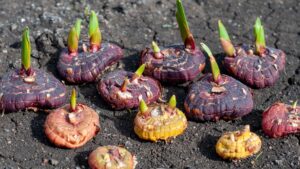Summer at last! School’s out, vacation’s just around the corner: it’s time to recharge your batteries. The weather is beautiful, the sun is shining, the heat is well established and the rain has been scarce for a few weeks. It’s perfect to enjoy the pool and go camping, but your lawn seems to be suffering: many yellow patches have appeared in the last few days. But what is it?
The chinch bug
A small circular patch appears on your lawn and the next day it has doubled in size? It may be the chinch bug. If your lawn is in direct sunlight or on an embankment, the risks are even greater. Also known as hairy chinch bugs, they feed on the sap of the grass, leaving it for dead. When you pull apart the grass, you will see small black or red insects. You have to act quickly, as chinch bugs reproduce at a rapid rate. Apply a pyrethrin-based insecticidal soap, available at garden centres.
White grubs
If your lawn pulls up like a carpet when you pull on it and birds and rodents come digging all over your yard in search of food, it’s quite possible that white grubs have taken up residence in your lawn. There are two over-the-counter products to control them. Ask your garden centre specialist about the best way to improve your situation.
Drought
If your lawn turns yellow and dry, like straw, it’s not an insect, but heat and lack of water. When heat and dryness are prolonged, the lawn goes dormant to protect itself. It concentrates all its energies on the roots to the detriment of the aerial part, which seems dead. As soon as the temperatures become milder, it will regain its beautiful green color. Avoid mowing and trampling during this period to avoid further stressing your lawn. If your local bylaws permit, you can water deeply once a week, ideally in the early morning or after sunset. But the lawn can survive 6 weeks of dormancy, so don’t worry too much.
Other insects, diseases or weather conditions can affect your lawn. A good diagnosis will allow you to identify the problem and put the right solutions in place.
A healthy lawn: your best ally
To prevent your lawn from being attacked by insects or from suffering from heat and lack of water, the best thing to do is to provide it with the right care so that it is thick and healthy:
- Mow regularly, to a height of 8 cm, and leave the clippings in place.
- Fertilize properly at different times of the year with a good 3 or 4 step fertilization program.
- Topdress and overseed in the spring or fall and repair bare or damaged areas quickly.
Need help figuring out what to do with your lawn? Take pictures and consult our in-store specialists who will help you take the right steps to ensure your lawn is at its best.
Have a great summer!








